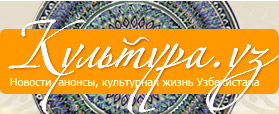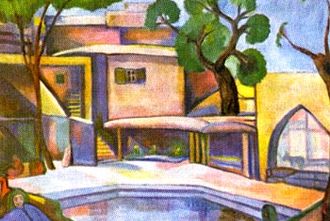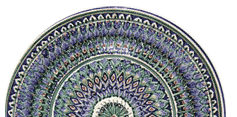| Мы освещаем новости культуры Узбекистана: театр, кино, музыка, история, литература, просвещение и многое другое. | 
|
|
|
|
14.09.2014 / 20:26:33
Traditions. The Mahallya The word mahallya is little known to people living outside of Uzbekistan so in order to get familiar with the word it is enough to read this article but to understand the essence of mahallya it is necessary to live in it at least a year. Mahallya is a city district or block. But however it is not at all like the ones we are familiar with in the other cities of the world. It is a peculiar settling of people who are linked by family bonds. It is a collective of people united by the rules and laws, traditions and joint work. It is a complex firm organism, the beginnings of which are folk wisdom, national traditions and practical activity. In order to gain an understanding of these formulations let's turn to history of town planning in Central Asia. City planning This way dahas were formed between the big streets. In each daha there was a separate kaziy (judge) and one mingbashi (a thousand's). The daha was divided into blocks mahallya, guzar (in Khiva they are called ilyat). The mahallya seniors aksakals were at the head of these dahas. Thus mahallya is the smallest administrative unit. Tashkent was divided into 4 dahas: Besh-Yoghoch, Kukcha, Sebzar, and Sheyhantaur. These names can still be found on the city map. The amount of mahallyas constantly changed. Thus in the middle of 19th century there were 48 mahallyas in Sheyhantaur, 38 in Sebzar, 32 in Besh-Yoghoch, 31 in Kukcha. In 1909 in Tashkent the first bus appeared and the first bus route started working. Ten eight-placed buses plied between Nikolskiy village (ex- Lunacharskiy highway, now Buyuk Ipak Yuli) and Kuylyuk. The buses were from Benz Gagenau.
The names of mahallyas. The youth celebrate weddings, build houses but there was not enough space so the young families left for the freer lands and built their homes there. Thus numerous mahallyas appeared with the names of which included the word yangi new. The other reason for the splitting up of mahallyas is economical. All the holidays (ethnical, religious, family and others) are celebrated conjointly in mahallyas. For this reason in each mahallya (in our times as well) a big choyhona was built (now it sometimes resembles a banquet hall) but it became unprofitable to invite the population of the entire mahallya, for example, to a wedding. One can see such names of mahallyas which reflect the remarkable events in of the city life. The mahallya Jangap Battle is called so because of the events of the 18th century. At that time there were 4 khakims (stewards) in Tashkent of which one of them from Sheyhantaur fought with the adherents of others. By the way, the governing of khakims of Tashkent was ended with this battle and the system of khakimiyats renewed noticeably later but only in the 90s of the 20th century. Another big group of mahallyas contains in its appellations the names of historical personalities, for example, Chagatay. Chagatay was one of the sons of Chingiz-han who apart from the territory of the modern Tashkent province also possessed the lands in east of Uzbekistan. His ruling differed by relative calmness in political as well as in the economic relation. In Tashkent the Chagatay mahallya is famous for its shashliks. It is located in the Old city district (reference point metro station Tinchlik). In many yards you will be deliciously fed by soups, salads and shashliks you just have to know in which. In this district there is the Chagatay restaurant with an interesting interior and once a beer named Chagatay was brewed there. A significant part of mahallyas in its names reflected the class stratification of society. The Bay-kucha mahallya was called so because it was inhabited by bays great landowners. A separate group is formed by mahallyas reflecting the peculiarities of architecture. Mahallya Baland-mosque stood out among others by its high mosque (baland tall), Pusht-l-hammam was located behind a sauna (hammam sauna), Pusht-l-bogh was located behind a garden (bogh garden), in the Olmazar mahallya once huge apple trees were growing (olma apple). Because of the development of Tashkent many mahallyas were demolished or rebuilt again (after the earthquake in Tashkent in 1966). The new many-storied buildings kept their names, for example, block Kara-tash (Black stone) not far from the metro station Drujba Narodov (friendship of nations) and block Besh-Yoghoch. The mahallyas Kor-yoghdi and Hadra have disappeared from the map of Tashkent. The Pahtakor stadium and Circus building is now on their place.
It was cleaned also rarely 1-2 times a year the water was let out and silt and loam was scooped out which of course meant sometimes epidemics arouse in mahallyas. Apart from this grocers were located here so one could buy lepyoshkas (flat cakes), kurt (balls from dry cottage cheese), nasvay (powder mixture of tobacco and limej, which oriental men put under the tongue (very rarely women). Here there were also the barber shops and small workshops for repairing shoes and copper crockery. The mosque stood out from other buildings with its walls from baked brick. All the other houses, with the exception of the rich people's houses were made from self-made clay bricks. Clay was mixed with chopped straw and water; bricks were formed and dried in the sun. Each spring green sprouts came out amicably and some roofs were completely overgrown. You will not be able to see these buildings in Tashkent anymore as well as in other cities. They remained only in kishlaks (villages).For building a new house men used to gather on hasher where everyone came for 2-3 hours to the neighbor and helped to lay bricks, hammer in bars and bring out garbage. Aged men aksakals in the morning after the prayers took their places in choyhonas, young men left for work, boys under 5-6 years jumped on sticks on streets, played ahichkas (Ashichkas articular bones of a sheep, the cavities of which were filled with lead. It was required to knock them down from a specific distance. The one who gains the most wins) and lyangas (Lyanga a piece of sheep wool with a coin or a piece of any metal stitched to it. It was required to hit the lyanga with a twisted foot or the toe of the foot the largest amount of time). 20 years ago ashichkas and lyangas were in use in the cities but now one can meet them very rarely. The girls with mothers stayed at home to keep house to sweep and water the floor, stitch quilts, embroider skullcaps, cook, bring water, make jams from fruits, clean the crockery, etc. On festive and not so festive occasions men went to one of the houses for morning plov (at 5-6 o'clock) and in the evening women gathered for festal toy. They brought baking in big basins (toghara) covered with clean table-cloths dastarhans for the festive table. Even now one can meet a dressed up woman with appetizingly smelling dish. Strict customs prevailed and prevail till now. A girl to be married or a young bride came out to sweep the yard or the area in front of the gates with the first rays of sunshine. The not removed leaves in front of the gates mean one thing: either the mistress of the house is ill, or a lazy woman leaves here. Life in urban apartments relieved many women from this necessity but however sometimes one can still see a young woman near a many-storied house. This means that in this family a wedding was celebrated not long ago and the bride is probably from a small city where this way of life remained. If you go along a mahallya, all the kiddies and oncoming people will certainly greet you. It is required to answer these greetings and you will feel the necessity of it yourself, without my advice. One wants to say something pleasant to the smudgy half-dressed children with smiles. With houses people inherit the corresponding status and respect and importantly those customs and norms of human relations which were formed through centuries. Mahallya today Many mahallyas have their own sport grounds and as decades ago in mahallyas there are clean streets with aryks (small irrigation ditches), fruit trees, which in spring abundantly cover the streets with white and pink petals and in summer with small fruits of cherries, apricots, apples. The fruits are usually not gathered from trees but are left to children. Among foreign specialists who live and work in Uzbekistan it is accepted to settle in mahallyas since this is pleasant, interesting and good for health. Источник: http://discoveruzbekistan.com/
|

|
|||||||||||||||||||||||||||||||||
 Mahallyas differed also by their sizes and amount of houses and grounds. For example, mahallya Ak-mechet (white mosque) in Shehantaur counted over 400 houses, mahallya Chuvachi in Sebzar over 100 houses, mahallya Samarkand-Darbaza in Besh-Yoghoch 50 houses. As time goes by each mahallya expands and divides into two or more small mahallyas. During this constant process it was not always possible to preserve the industrial character. Even if rarely, the youth choose their spouses from mahallyas the inhabitants of which were engaged in other handicraft. Historically one more type of mahallya formed the settling of people on the nationality basis. Starting from 2-3 families they grew into quite large ones. In the course of time in many cities of Uzbekistan the Tajik, Iranian, Jewish and many other mahallyas appeared.
Mahallyas differed also by their sizes and amount of houses and grounds. For example, mahallya Ak-mechet (white mosque) in Shehantaur counted over 400 houses, mahallya Chuvachi in Sebzar over 100 houses, mahallya Samarkand-Darbaza in Besh-Yoghoch 50 houses. As time goes by each mahallya expands and divides into two or more small mahallyas. During this constant process it was not always possible to preserve the industrial character. Even if rarely, the youth choose their spouses from mahallyas the inhabitants of which were engaged in other handicraft. Historically one more type of mahallya formed the settling of people on the nationality basis. Starting from 2-3 families they grew into quite large ones. In the course of time in many cities of Uzbekistan the Tajik, Iranian, Jewish and many other mahallyas appeared. Way of life in mahallya
Way of life in mahallya












